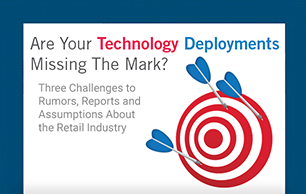While retail publications, events and analysts are bursting with excitement about the potential for artificial intelligence (AI), most retailers have yet to realize the transformational impact of AI in their day-to-day businesses. With so much discussion around the power of AI, retailers are beginning to deploy this capability for specific applications and explore the ROI. Visions of spot-on recommendations for shoppers who are overwhelmed with choices, virtual dressing rooms that allow consumers to compare outfits they have tried on, and custom nutrition, allergy and promotion information that is pushed to consumers as they shop, paint a picture of the new optimized customer shopping experience. The potential to drive increased revenue per shopper, decrease shopping cart abandonment, and fulfill orders without error is real.
Savvy retailers, however, know that deploying a new technology is a journey that involves a multi-step, complex process including ROI calculation, securing buy-in across multiple departments, piloting the technology prior to large-scale rollout, and careful results tracking. Retailer margins simply don’t allow for hapless installation of every new technology out there.
What are some of the keys to successful implementation of AI? Here are a few suggestions.
Start with use cases
The applications for AI are virtually endless. As a result, it is critical that you carefully consider and map out how you want to use the technology. Is AI deployment going to support better inventory management or customer segmentation? Start with one or two compelling applications and get stakeholders across the board involved. This is not plug-and-play technology, so planning for a device-style deployment is not sufficient.
Revisit your infrastructure
The successful deployment of AI requires robust and secure infrastructure for the transfer and protection of large amounts of data. The infrastructure of the future is AIDI (AI defined infrastructure), which uses AI to create a self-supporting intelligent network, where machine learning provides for self-healing, self-routing architecture and auto-integration of new devices. In absence of the ideal, AIDI network to support your AI applications, you can still take some steps to bridge the gap. First of all, AI requires lots of computing power and storage. Make sure you have sufficient resources to handle what will likely be a significant increase in traffic and usage.
You can also consider deploying AI-driven technologies in specified areas of your infrastructure. Security is a good place to start. AI technologies can efficiently point to unwanted devices, traffic and potential breaches that may not be as quickly identifiable by IT teams. There is also potential to install cloud-managed wireless infrastructure that leverages machine learning to optimize wireless performance and security. Until your infrastructure is completely AI directed, layer in sufficient bandwidth, security and performance enhancements where you can.
Vet your data sources
Whether constructing a simple database or preparing for AI, careful evaluation of data sources is critical to success. The old mantra still holds true: junk in = junk out. Think your data is fine? Consider, for example, if your cashiers’ practice is to submit the date 1/1/91 for every person that is over the drinking age when ringing up alcoholic beverages. Or if customers when putting in customer info tend to enter 800-000-0000 as their phone number. AI will derive some extremely incorrect information. To avoid problems, simply take time to consider the optimal sources of data prior to deploying AI and even take time to run data validation tests.
Communicate with your people
Science fiction movies have painted a less-than-attractive picture of the potential for robots to take over the world. Employees understand the potential for machines to reduce the labor force. Get buy-in and face down fears of replacement of employees. Communicate openly and often about the initiative, what it will mean to employees and how their support is critical to the success of the project.
AI delivers some capabilities that can truly take retailers to the next level, improving the customer experience, improving the efficiency of back-end operations, and multiplying the workforce. These benefits all deliver ROI, whether in the form of increased revenues, reduced costs, or increased customer loyalty. Dive in to realize these benefits, but plan carefully to ensure the success of this major initiative.




